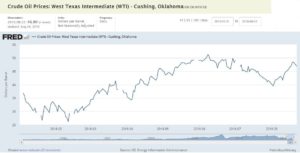- August 31, 2016
- Mike Minter

Commodities such as oil, gold, agriculture, etc., can make for a difficult investment. As an investor, sometimes the experience is far different from what you expected.
Investing in a public company is pretty straight forward. When you buy stock you now own a piece of that company, albeit usually pretty small. You are now technically entitled to your share of the company’s earnings and any voting rights attached to the stock. There really is nothing tangible about stock ownership – there is no real asset to touch or feel.
Commodities investing is very different. These are physical assets used in the real world for consumption, production, and transportation. Some investors will buy commodities, such as gold or silver, in physical form and actually store it in secure locations. But most commodities investors don’t have any intention of accepting delivery of the physical assets.
Take oil for example. What individual investor actually wants to take possession of barrels of oil? Not many. Investors want to participate in the upside of the price of oil, without actually taking physical possession. This is where it gets tricky.
For the individual investor, the most common form of commodities investing today is via an ETF (exchange-traded fund). And the fund does not actually take delivery of physical assets either, so it uses a vehicle called a futures contract. The futures contract entitles the owner to receive the physical commodity upon the settlement date, but before this occurs the fund will “roll” to the next futures contract to maintain exposure to the asset price without taking delivery. This “rolling” of the contract can present major challenges.
Let’s look at the United States Oil Fund (USO) for example. This fund is designed to track the price movements of WTI crude oil prices. Hot dog! This fund should have hit a home run in 2016 with the dramatic rise in crude oil prices. As you can see below, WTI Crude prices have risen around 27% this year:

Well, investors in USO have had a dramatically different experience this year. Almost unbelievably, this fund which tracks crude oil has actually lost around -2.40%. So how does something like this happen? You’ll sometimes see scenarios like this when each month’s oil keeps trading at higher prices. When USO rolls to the next oil contract, it essentially has to “sell low, and buy high” every month. This vicious losing cycle is an investing phenomenon known as “contango.”
This can be a nasty surprise for investors hoping to mimic the price movements of the underlying commodity. Any upward price movements in the commodity can be offset by the higher futures contract prices and expenses of the fund.
I don’t mean to pick on USO – there are many funds that have experienced the adverse effects of contango. There are also many managers that have much more flexibility in how they roll their contracts, and have managed to combat contango effectively.
In most of our clients’ portfolios we have a small allocation to a broad basket of commodities like oil, precious metals, agriculture, etc. We gain exposure to these commodities through the PIMCO CommoditiesPLUS Strategy Fund. The managers of this fund have flexibility in how they deal with the futures prices and contract rolling, and have been very successful with the implementation.
In small doses, commodities exposure can add value to an investment portfolio by increasing the diversification. But it helps to intimately understand the investment vehicle chosen, or you could be in for a rude awakening.
Sources: CNBC, Morningstar Direct, FRED




